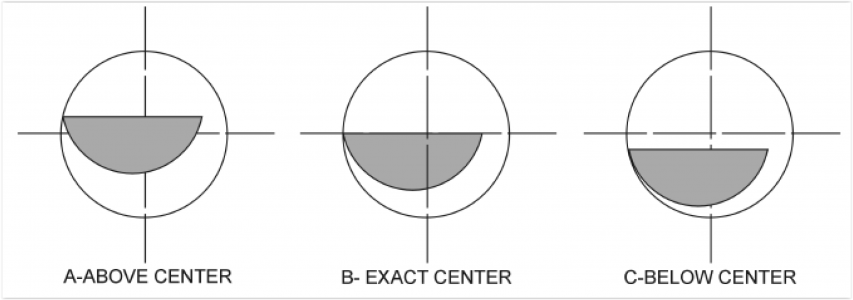Hey, Mikey, how about a tutorial on mill cutting tools, and their differences from external cutting tools???

Yeah, this is a huge discussion that I haven't finished writing up but I can maybe give you guys my opinion, for what that's worth.
Correct me if I'm wrong but I think what Tony is referring to is how the alignment of the cutting edge impacts on tool performance. Essentially, this is tool geometry but it also impacts on the accuracy of the feed leadscrew. Have a look at this graphic from Criterion:

The ideal tool orientation is B. Note that the tip of the cutting edge is on center and there is adequate relief under the edge; this does two things. It provides adequate clearance while still providing adequate support under the cutting edge for strength. Second, it allows for maximum accuracy from the feed leadscrew; what you dial in is what you get because the point of contact is in line with the direction of the feed leadscrew.
"A" is what you have with a brazed carbide tool, or at least the Chinese versions most of us own. The carbide stands proud of the centerline of the tool so with the tool inserted into the boring head the top of the insert projects beyond the centerline. This is problematic because this essentially amounts to negative rake, which increases cutting forces and can produce chatter if this offset is extreme. It also messes with our accuracy because now we do not get what we dial in. The cutting edge is no longer aligned with the feed leadscrew so who knows what we'll get. One way to counter this is to rotate the tool in a counterclockwise direction as Bob suggests, bringing the cutting edge on center; this accurizes your feed. However, the downside is that you now have all the cutting forces in that tip and edge, with very little support underneath so your tool will be weaker and can break down quicker. In spite of this, like Bob, this is how I do it when using these bars.
In "C", the tool has to be improperly constructed or severely worn in order to get this scenario. I have not seen this alignment myself.
The question is whether using a brazed tool, as in "A", will work. Yes, it will because the offset from centerline is very small. It will be less accurate but the tool will definitely cut ... but it can cut better if you bring the tip/edge on center. Rotating it a tiny bit CCW will accurize the leadscrew and create positive rake, all at the same time.
Personally, I rarely use cabide tools in a boring head, brazed or inserted. I prefer a HSS-cobalt tool from Borite. These tools have tapered shanks with the smaller diameter towards the cutting head; this reduces resonance and, therefore, chatter. Borite tools are also accurately ground so that the top rake surface of the tool is on the centerline of the tool shank, making it simple to align the tool accurately. These bars are easily sharpened, although they hold an edge for a long time, and they finish really well.
I don't use inserted carbide tools anymore, mainly because I have to use too much speed to obtain an adequate finish. On small holes, this is not really a problem but once I get out to 2" or more then centripetal forces get too large and the mill vibrates. Criterion came out with a counterbalancing bar to combat this but I've been too lazy/busy to make one but it is on the list of stuff to make.
One more thing and I'll stop. Boring on the lathe is controllable to a great extent. It takes skill but you can cut a hole dead on size on the lathe if you know what you're doing. On the mill, with a boring head, it is far less controllable. I think of boring on the mill as "cut and try". You dial in a cut and given your cutting conditions, material, cutting oil, bar, head, direction of the wind and phase of the moon, you get what you get. The reason for this uncertainty is that in addition to the same three cutting forces we always have to contend with (tangential, radial and axial), we must also contend with centripetal forces. Depending on the bar we use, the material we cut, the size of the hole and the cutting conditions we're using (speed, feed and depth of cut), it is nearly impossible to anticipate how the three cutting forces will interact with centripetal forces to allow us to predict the cut. The best we can do is set things up, make a cut and see what results. Then we dial in the next cut and see what that does. And this is made worse when using inserted carbide because the geometry and nose radius introduce their own cutting requirements and influence on cutting forces. In spite of this, you can bore pretty accurately by the cut and try method. Machinists do it all the time but you do not have the degree of control you have on the lathe; well, at least I don't.
The whole thing is a really complicated affair, which is why I haven't finished my piece on boring on the mill ...



 With the correct bars and tooling , it's quite easy to hold .0001 when boring on a mill . With some of the stuff out there now , I wouldn't want to attempt it
With the correct bars and tooling , it's quite easy to hold .0001 when boring on a mill . With some of the stuff out there now , I wouldn't want to attempt it 